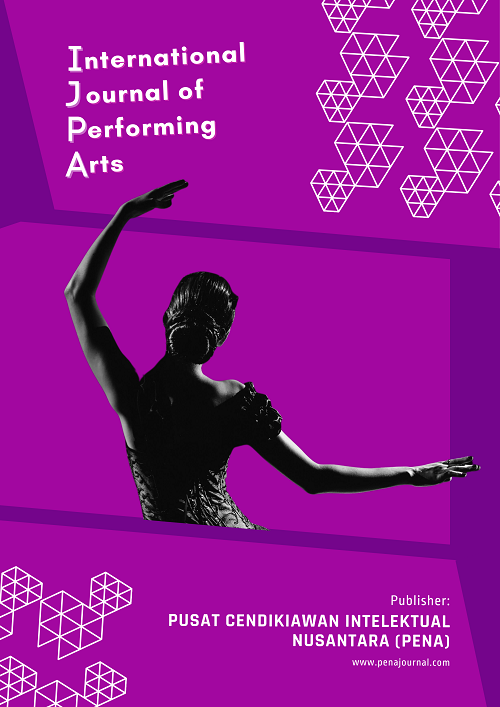BRIDGING THE THEORY-PRACTICE GAP IN ART EDUCATION: A STRUCTURED PEDAGOGICAL MODEL FOR CRITICAL AND CREATIVE APPLICATION
BRIDGING THE THEORY-PRACTICE GAP IN ART EDUCATION: A STRUCTURED PEDAGOGICAL MODEL FOR CRITICAL AND CREATIVE APPLICATION
DOI:
https://doi.org/10.56107/ijpa.v4i1.249Abstract
Higher art education emphasizes theoretical mastery as a crucial foundation, yet many students
struggle to apply this knowledge in both criticism and creation. The persistent gap between 'knowing'
and 'doing' remains a critical challenge in art pedagogy, often hindering learning outcomes. This
article proposes a structured pedagogical model designed to bridge this divide. By synthesizing
Scaffolding Theory and Situated Learning Theory, the model presents a systematic four-step
framework: (1) theoretical deconstruction for deep comprehension, (2) methodological bridging
between theory and artistic objects, (3) dialogic operationalization through analytical frameworks,
and (4) simulation and analytical design. This model is demonstrated through a case study applying
Homi K. Bhabha’s Cultural Hybridity Theory to Lenong Betawi, a traditional Indonesian
performance art. The proposed framework offers practical guidance for art educators to transform
students’ passive theoretical knowledge into active analytical and creative competence. It
contributes to the field of art pedagogy by integrating established educational theories into a
coherent, actionable strategy for teaching theory application in art practice
References
Al Fahmi, F. F., Nazwa, S., Mukaromah, L., & Syahizafudin, S. (2024). Akulturasi budaya Betawi
dan Islam dalam kesenian Gambang Kromong. Jurnal ISME Kajian Islam dan Penelitian
Multidisiplin, 2(1), 53–63. https://doi.org/10.61683/isme.vol21.2024.53-63
Ashcroft, B., Griffiths, G., & Tiffin, H. (2007). Studi pascakolonial: Konsep-konsep kunci (3rd ed.).
Routledge.
Barrett, T. (2011). Criticizing art: Understanding contemporary art (3rd ed.). McGraw-Hill.
Bhabha, H. K. (1994). The location of culture. Routledge.
Chaer, A. (2015). Betawi tempo doeloe: Menelusuri sejarah kebudayaan Betawi. Masup Jakarta.
Davis, M. (2019). Bridging the gap: Challenges students face in applying theory to studio practice.
International Journal of Art & Design Education, 38(4), 792–805.
https://doi.org/10.1111/jade.12258
Efland, A. D. (2002). Art and cognition: Integrating the visual arts in the curriculum. Teachers
College Press.
Elkins, J. (2001). Why art cannot be taught: A handbook for art students. University of Illinois Press.
Freire, P. (1970). Pedagogy of the oppressed. Continuum.
Gray, C., & Malins, J. (2004). Visualizing research: A guide to the research process in art and
design. Ashgate Publishing.
Hatley, B. (2008). Javanese performances on an Indonesian stage: Contesting culture, embracing
change. NUS Press.
Heuken, A. (1999). Sumber-sumber asli sejarah Jakarta sampai dengan tahun 1630 (Vol. 1).
Yayasan Cipta Loka Caraka.
Johnson, R., & Lee, S. (2022). The evolving role of conceptual frameworks in contemporary art
creation. Journal of Aesthetic Education, 56(1), 88–104.
https://doi.org/10.5406/jaesteduc.56.1.0088
Lave, J., & Wenger, E. (1991). Situated learning: Legitimate peripheral participation. Cambridge
University Press.
Perkins, D. N. (1993). Teaching for understanding. American Educator, 17(3), 28–35.
https://doi.org/10.1086/444043
Pfeffer, J., & Sutton, R. I. (2000). The knowing-doing gap: How smart companies turn knowledge
into action. Harvard Business School Press.
Schön, D. A. (1983). The reflective practitioner: How professionals think in action. Basic Books.
Sears, L. J. (1996). Shadows of empire: Colonial discourse and Javanese tales. Duke University
Press.
Smith, A. (2020). Artistic practice: Intersections of theory and creativity. Routledge.
Sullivan, G. (2010). Art practice as research: Inquiry in visual arts (2nd ed.). SAGE Publications.
INTERNATIONAL JOURNAL OF PERFORMING ARTS
https://penajournal.com/index.php/IJPA/ 9
Thomas, J. W. (2000). A review of research on project-based learning. Autodesk Foundation.
Walker, S. (2006). Sustainable by design: Explorations in theory and practice. Earthscan.
Whitehead, A. N. (1929). The aims of education and other essays. Macmillan.
Wood, D., Bruner, J. S., & Ross, G. (1976). The role of tutoring in problem solving. Journal of Child
Psychology and Psychiatry, 17(2), 89–100. https://doi.org/10.1111/j.1469-
1976.tb00381.x
Young, R. J. C. (2001). Postcolonialism: An historical introduction. Blackwell Publishing.





















